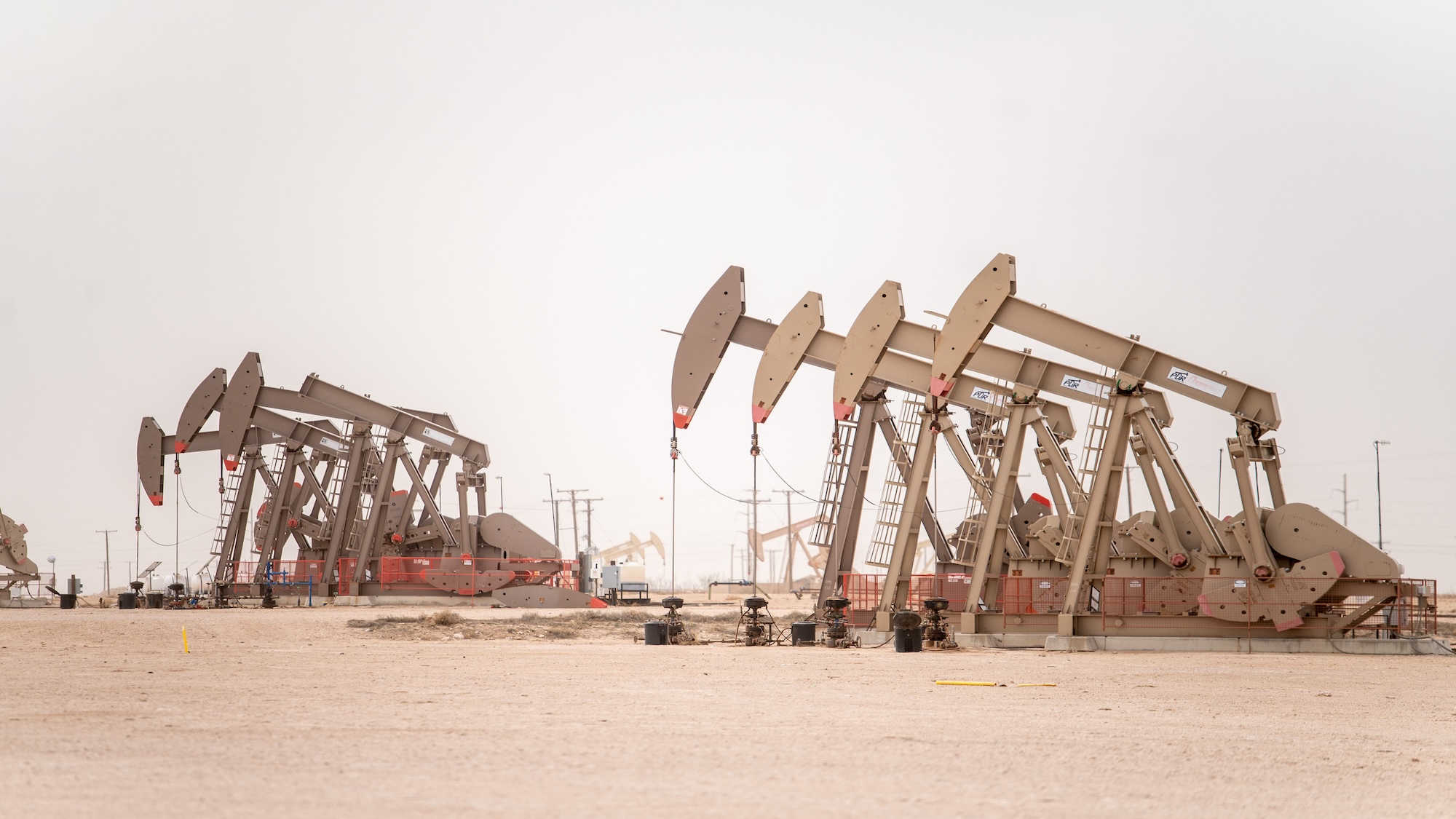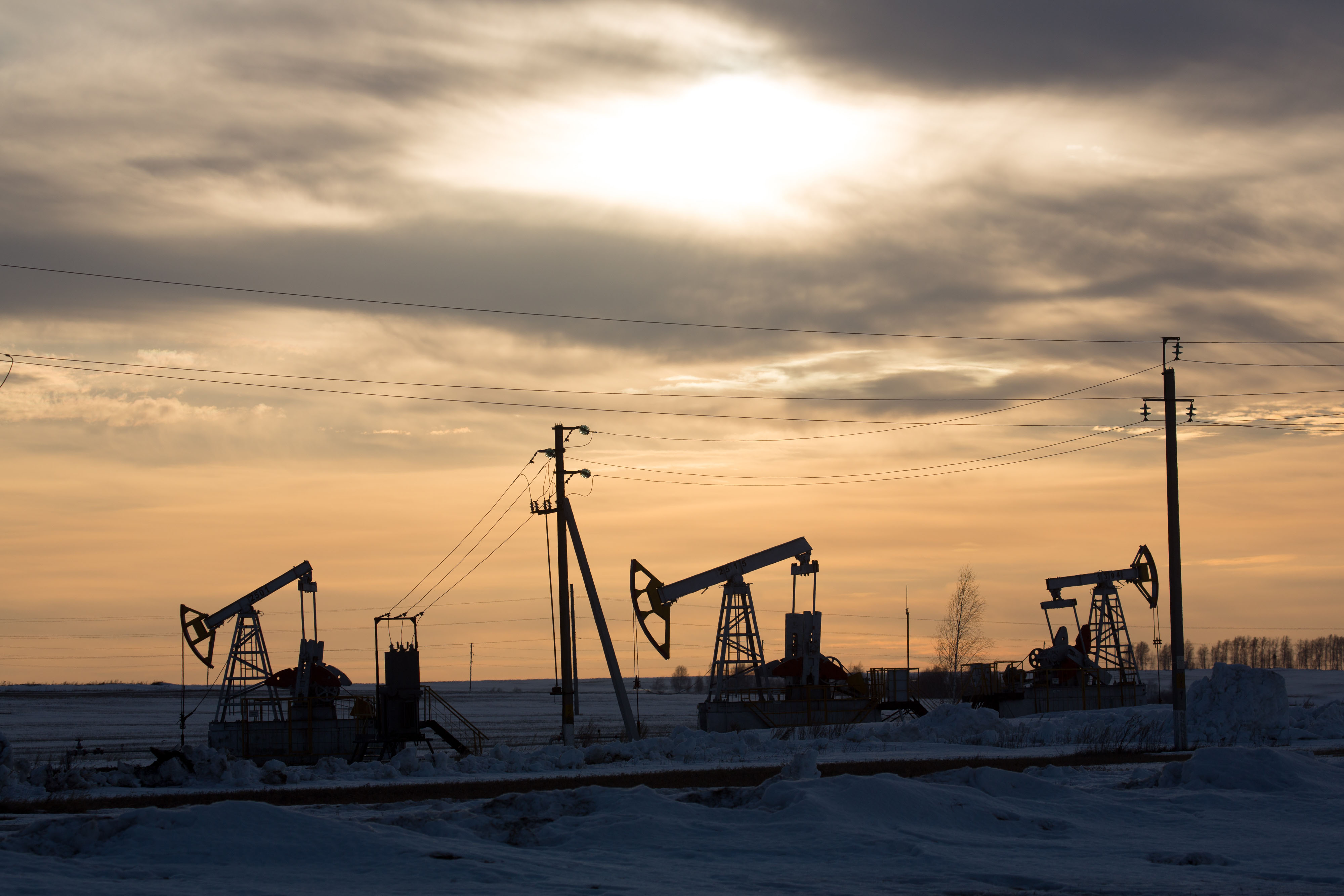Oil price posts two-year highs - but how long can it last?
Brent rose above $59 a barrel this week, its best third-quarter showing since 2004

Supply fears take oil price to lowest level in a week
19 January
The oil price fell by close to three per cent yesterday to hit its lowest level in a week.
International benchmark Brent crude dropped 2.8 per cent to below $54 a barrel. Its US counterpart, West Texas Intermediate, slipped by a similar margin to around $51.
The Week
Escape your echo chamber. Get the facts behind the news, plus analysis from multiple perspectives.

Sign up for The Week's Free Newsletters
From our morning news briefing to a weekly Good News Newsletter, get the best of The Week delivered directly to your inbox.
From our morning news briefing to a weekly Good News Newsletter, get the best of The Week delivered directly to your inbox.
The dip came after the International Energy Agency forecast US shale oil output would increase by almost 41,000 barrels per day in February, says Reuters. Production had been expected to continue to decline by around 6,000 barrels per day.
The reversal reflects the relative stability of the oil price above $50 following the pledge by Opec, Russia and others to cut output by 1.8 million barrels per day. However, it also threatens to undermine the impact of the promised drop in production.
Reuters reports that Opec also published a report yesterday which "pointed to the possibly of a rebound in US output". It still expects the ongoing supply surplus in the market to "tighten", however.
Oil has been oversupplied for two years. Until it is established that the big global producers are sticking to the agreed reductions – and how this is affecting the wider market – the oil price is expected to remain volatile.
A free daily email with the biggest news stories of the day – and the best features from TheWeek.com
Further evidence of this came this morning, with Brent rising by a little less than one per cent to $54.40 a barrel following a report from the American Petroleum Institute that showed crude oil stocks in the US fell by five million barrels last week, says Reuters.
This bullish signal on demand versus supply was tempered by "larger-than-expected, and potentially bearish, increases in stocks of gasoline and distillates", which suggest underlying demand remains weak.
Oil price falls again- and voltatility will continue, says IEA
18 January
Oil prices fell this morning on the latest prediction that the US shale industry could ramp up production and offset cuts being made elsewhere.
Trading is stuck in the mid-$50s per barrel and currently being pulled in both directions – and according to the International Energy Agency (IEA), volatility is "the name of the game" for the rest of this year, reports the Daily Telegraph.
Brent crude fell 1.3 per cent to below $55 a barrel in London trading this morning, while its US counterpart, West Texas Intermediate, dropped 1.4 per cent to below $52.
The dip was prompted by a report late on Tuesday by the US Energy Information Administration (EIA) that output from shale producers in the country will "snap a three-month decline in February", says Reuters.
"February production will edge up 40,750 barrels per day (bpd) to 4.748 million bpd, the EIA said. In January, it was expected to drop by 5,900 bpd," said the news agency.
There has long been speculation that a prolonged spell for the oil price above $50, which means relatively expensive shale production is mostly profitable, will prompt a recovery in the sector.
But this could offset the 1.8 million barrel per day cuts agreed by Opec, Russia and others, which was the driving force behind a big oil price rally from the low-$40s a barrel in November.
For the past two years, the oil price has been dragged lower by a global supply glut, which amounted to an attempt by Opec, led by Saudi Arabia, to drive back booming shale oil businesses in the US.
IEA executive director Fatih Birol said the markets were on a path to rebalancing, but warned: "We are entering a period of much more volatility."
He added that as a result of a huge withdrawal of investment in drilling in recent years by big producers, whose profits have been hit by the slump, the market could ultimately see a major price spike in the years ahead.
"This year, if there are no major investments coming, we may well see in a few years from now significant supply-demand gap with serious implications on the market," he said.
Oil price being dragged both ways by contrasting news
17 January
Oil prices were mixed this morning as news from Saudi Arabia and the US pulled traders in opposite directions.
Brent crude, the international benchmark, stood at $55.76 per barrel, down ten cents from their last close, but US West Texas Intermediate was up 15 cents at $52.51 per barrel.
Boosting trade is Saudi Arabia's announcement that it will adhere to the Opec commitment to cut output. However, scepticism that the cartel as a whole will comply, along with rising US production, dragged prices down.
Under the output agreement, both Opec and several other leading oil nations, most notably Russia, have pledged to cut production by nearly 1.8m barrels per day for at least six months to try and bring supplies back in line with consumption.
"The market genuinely seems quite happy here (around $55)...but people are watching with caution as the slightest hint of this Opec/non-Opec agreement going wrong is going to drive the market down," said Matt Stanley, a fuel broker at Freight Investor Services in Dubai, told Reuters.
Crude futures have fallen five per cent since their early January peaks amid doubts the producers will fully comply with the cuts. DailyFX quotes Saudi energy minister Khalid Al-Falih as saying that extending the deal past the middle of the year is probably unnecessary, which may weigh further on prices.
Meanwhile, the Financial Times reports that Kuwait has finalised plans for its first-ever sale of dollar-denominated debt, extending the rush of mega-bond deals from Gulf states grappling with lower oil prices.
Oil price swings higher after triple-whammy boost
12 January
Earlier losses for the oil price yesterday were reversed into a near three per cent gain by the end of the day, with oil prices almost one per cent higher this morning.
The commodity benefitted from a triple-whammy of good news relating to a landmark deal to cut global production and greater demand in China and Forex markets. The news eclipsed a bearish report on crude reserves.
Brent crude, the international oil price benchmark, fell below $53.50 a barrel at one point on Wednesday morning, but was back above $55.60 by 11am this morning.
Its US counterpart, West Texas Intermediate, dropped below $51 a barrel, but rebounded to $52.60 this morning.
Behind this rise were comments from the secretary-general of Opec, Mohammad Barkindo. He said that the powerful cartel's members were abiding by the terms of the 1.2 million barrels per day cut in output and that this would be effective from this month onwards.
"According to BMI Research, initial compliance to the agreement appears to be positive… at around 73 per cent," says Market Watch.
The production deal, which is the cartel's first in eight years – and has been followed by similar pledges from Russia and other non-Opec states – prompted a prolonged rally for oil from its nadir in the low $40s in November.
Jabar Ali al-Luaibi, the oil minister for Opec's second largest producer, Iraq, which is the country considered most likely to renege on the deal, told reporters on Thursday that Iraq had reduced its oil exports by 170,000 barrels per day.
According to Reuters, Luaibi said that Iraq would remove a further 40,000 barrels per day this week in order to meet its target to cut 210,000 barrels.
Elsewhere, oil prices were boosted after a chaotic press conference by President-elect Donald Trump hit the dollar. As oil is priced in dollars, this reduces costs for overseas buyers.
This is seen as positive for demand. It came on the day that it was reported that demand from China, the second-largest oil market in the world, rose to the second-highest on record in November.
These factors combine to make a bullish case for demand finally outstripping supply after two years. Traders overlooked a report from the US energy regulator showing that crude oil stocks in the country rose by four million barrels last week.
Oil price rally could be 'running out of steam'
10 January
Fears Iraq will fails to meet its production cuts target saw the oil price lose four per cent by the end of New York trading on Monday.
Brent crude, the international benchmark, lost more than $2 a barrel to settle at less than $55. It recovered only marginally this morning to $55.13 a barrel. Its US counterpart, West Texas Intermediate, also fell more than $2 a barrel yesterday to below $52, ticking up modestly this morning to $52.18.
The drop coincides with "bullish sentiment from speculators… showing early signs of abating, raising the possibility that the oil rally is running out of steam", Nick Cunningham writes on Oilprice.com.
Iraq's oil ministry also revealed exports from the southern port of Basra reached a record of 3.5 million barrels a day in December.
Baghdad has pledged a production cut of more than 200,000 barrels a day starting this month, but is facing a fight to convince the rulers of its semi-autonomous Kurdish region in the north to take a share of the burden.
"Sources also [said] that Iraq's State Oil Marketing Company had given three buyers in Asia and Europe full supply allocations for February," says Reuters.
Coupled with rising drilling activity in the US, this is giving investors the jitters despite Saudi Arabia and Russia honouring their own commitments to cut output.
As such, a two-month long oil rally that has taken the price from the low $40s - and which was expected to take it as high as $70 - is seen by some as under threat.
Cunningham reports that "long" positions, bets on prices being higher in the future, are effectively maxed out, meaning there is significant "near-term downside risk".
He adds: "All it will take is a bit of bearish news to spark a downturn in prices."
-
 Why is Trump’s alleged strike on Venezuela shrouded in so much secrecy?
Why is Trump’s alleged strike on Venezuela shrouded in so much secrecy?TODAY'S BIG QUESTION Trump’s comments have raised more questions than answers about what his administration is doing in the Southern Hemisphere
-
 Vance’s ‘next move will reveal whether the conservative movement can move past Trump’
Vance’s ‘next move will reveal whether the conservative movement can move past Trump’Instant Opinion Opinion, comment and editorials of the day
-
 Why recognizing Somaliland is so risky for Israel
Why recognizing Somaliland is so risky for IsraelTHE EXPLAINER By wading into one of North Africa’s most fraught political schisms, the Netanyahu government risks further international isolation
-
 How might the Israel-Hamas war affect the global economy?
How might the Israel-Hamas war affect the global economy?Today's Big Question Regional escalation could send oil prices and inflation sky-high, sparking a worldwide recession
-
 Recent mega-mergers could signal a turning point for the US oil industry
Recent mega-mergers could signal a turning point for the US oil industryTalking Point Both Chevron and Exxon have recently spent billions to acquire smaller oil companies
-
 Has Saudi Arabia lost control of oil prices?
Has Saudi Arabia lost control of oil prices?Today's Big Question Kingdom goes it alone to cut production, risking tension with US and reigniting cooling inflation in Europe
-
 US angered by Opec+ oil cut
US angered by Opec+ oil cutSpeed Read Energy prices to rise further as producers slash supply by two million barrels a day
-
 Global oil demand forecast lowered for 2020 and 2021
Global oil demand forecast lowered for 2020 and 2021Speed Read IEA report says jet fuel demand remains the major source of weakness
-
 Are US-Iran tensions flaring again?
Are US-Iran tensions flaring again?In Depth Trump threatens military action over Twitter
-
 Can a deal be struck to raise oil prices?
Can a deal be struck to raise oil prices?In Depth Opec+ will convene today over video link in a bid to boost crude
-
 What do negative oil prices mean?
What do negative oil prices mean?In Depth Perfect storm of oversupply and storage shortages sees producers paying to get rid of US crude